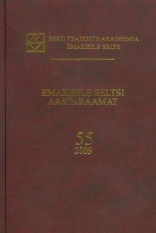MURDELIIGENDUSED XVI–XVIII SAJANDI EESTI KIRJALIKES ALLIKATES
ESTONIAN DIALECT DIVISIONS IN 16TH TO 18TH CENTURY TEXTS
Author(s): Siim AntsoSubject(s): Language studies, Theoretical Linguistics, Phonetics / Phonology, Sociolinguistics, Finno-Ugrian studies
Published by: Teaduste Akadeemia Kirjastus
Keywords: Estonian; Estonian dialects; sociolinguistics; colonial linguistics; historical perceptual dialectology;
Summary/Abstract: The article examins the formation of Estonian dialect divisions in the works of various authors of the 16th to 18th century. The selected texts were analyzed from a socio- and colonial linguistic viewpoint. The origin of linguistics and dialectology in Estonia is foreign, as research was conducted by Baltic Germans. In the perspective of colonial linguistics, the effort to learn the local varieties and bring order to the languages was done not only to communicate better with the locals but also to impose cultural domination. Thus languages were modelled after the ruling class’s mother tongue or Latin. The analysis also takes into account the effects of human and natural boundaries on dialect divisions, such as administrative borders, rivers, and forests. The texts analyzed were for the most part of a linguistic nature, being grammars sometimes accompanied by dictionaries. However, some works of history where neighbouring languages were described from a dialect paradigm were also included. For the most part, larger historic administrative units were used to describe the dialect situation in 16th to 18th-century texts. On many occasions larger cities were used to mark a dialect area. In the case of Tartu and Tallinn, specific city language varieties were named to distinguish them from the surrounding dialect area. This kind of a distinction is expected, since the ongoing dispute between the Tartu and Tallinn written language had an immense effect on the whole dialect system. The impact of natural obstacles was almost non-existent in the analyzed texts. It should be noted, however, that the current method only allowed for analysis of the texts themselves and the confirmed and plausible connections between them. Thus, a detailed inquiry with further material is yet to be conducted.
Journal: Emakeele Seltsi aastaraamat
- Issue Year: 2017
- Issue No: 63
- Page Range: 9-30
- Page Count: 22
- Language: Estonian

